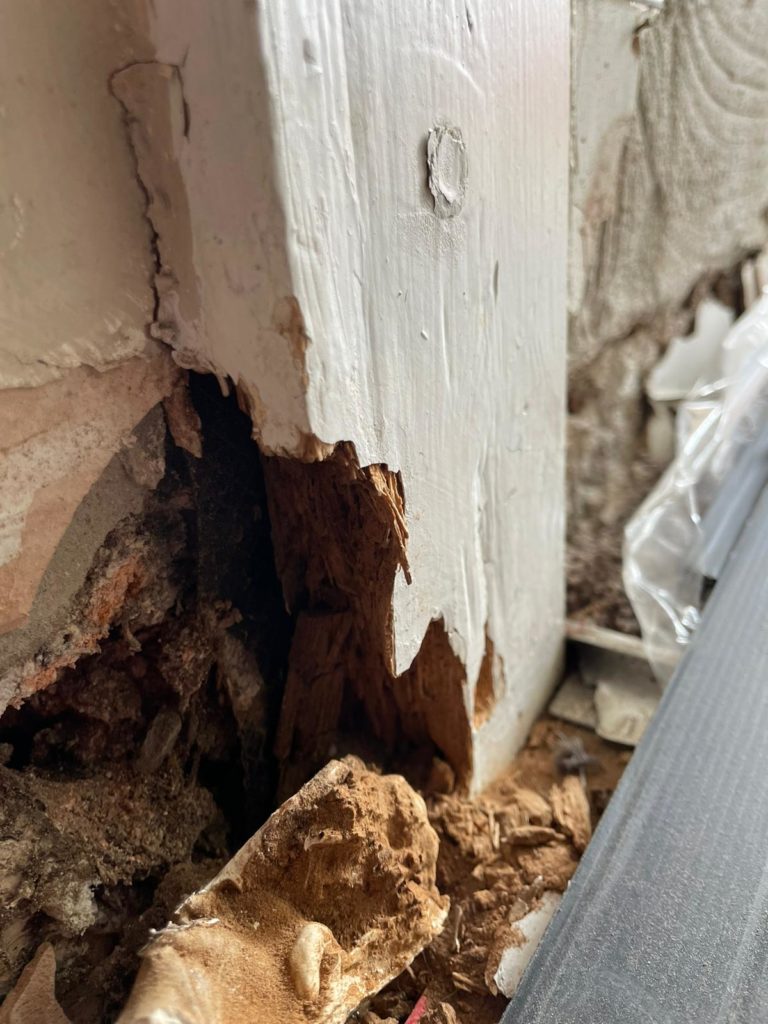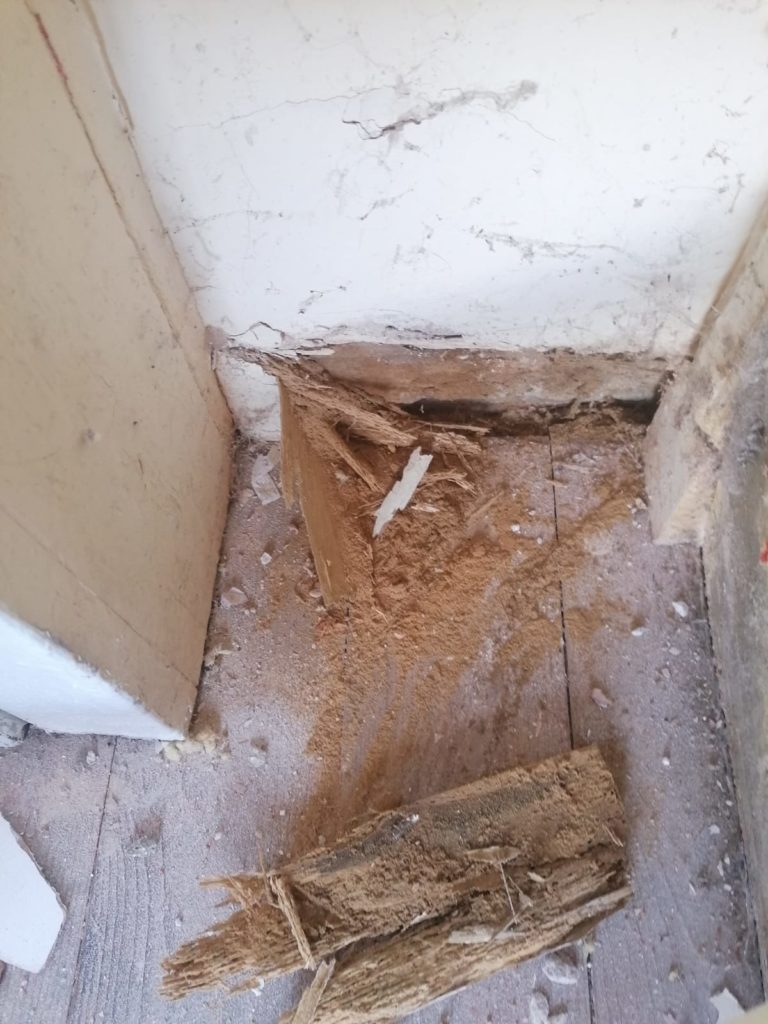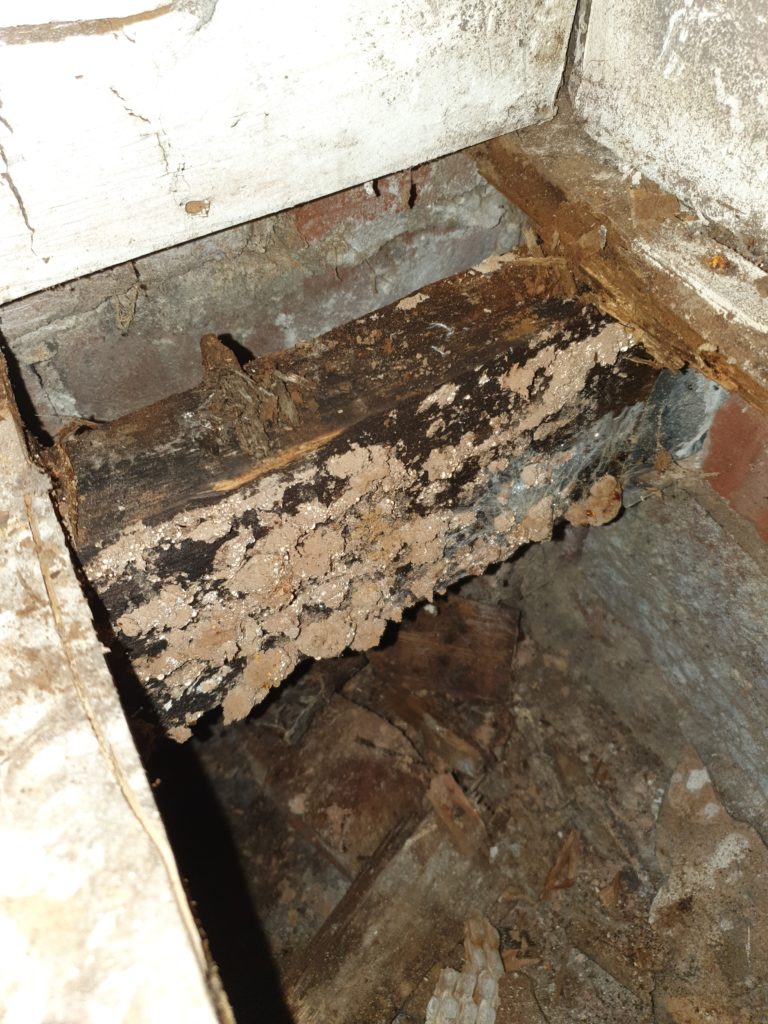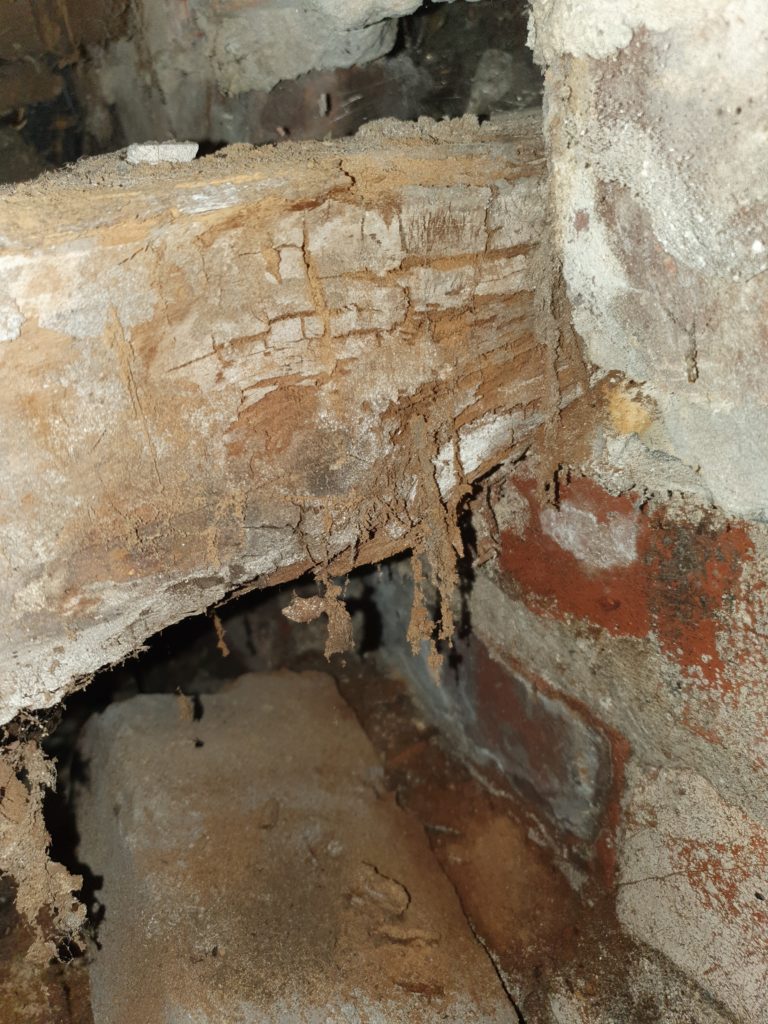What is wet rot?
Wet rot describes a group of wood-destroying fungi (Basidimoycetes) that attack the cellulose or lignin in timber, leaving it brittle and weak. Both brown rot and white rot are types of wet rot, with the exception of Serpula Lacrymans – also known as dry rot.
Wet rots generally thrive on a higher timber moisture content than dry rot, but do not spread through the masonry, and fungus growth stops when the moisture is removed.
The most common type is Coniophora puteana (cellar fungus). Other species include Fibropporia vaillantii (mine fungus) and Phellinus spp.


How to identify wet rot?
What makes the identification problematic for property owners, is that it often progresses in non-visible areas of your property, such as behind stairs, in the loft or attic and underneath flooring. Due to the difficulty in seeing such areas, it is not uncommon that what started as a minor issue, has progressed into a larger problem.
Another problem with identification is distinguishing wet rot from dry rot. A layperson might not be able to distinguish one from the other, nor notice an infestation whilst it’s still in its beginning stages; especially considering how tricky it can be to find in the first place.
So, to help you stay vigilant, here are some of the top signs that your property might have a problem:
- Check your property’s timber for signs of localised fungal growth
- If your timber has been affected by wet rot, it tends to feel soft and spongy although can also feel brittle, so don’t be afraid to touch and prod the timber in your property. It can even feel soft through a coat of paint, or you might notice that affected sections of timber look darker that timber that surrounds it
- When wet rot affected timber is dry, it will be incredibly brittle and crack/crumble easily. Again, don’t be afraid to handle the timber to see if it crumbles into tiny particles
- You may notice that wood around doors and windows has a bleached effect, like the colour is running, or has gone a different shade to surrounding timber
- Paintwork can be an indication of its presence. If paint on the timber looks flaky or damaged, you could have wet rot. A good way to check is by taking a thin blade knife and pushing it into the painted timber. The knife should stop after a short distance or meet hard resistance immediately. If you can easily slide the blade in up to the hilt, this is a sign of wet rot
- A damp and musty smell in your property would be a sign of wet rot, and a good way to identify it without being able to see it properly
What causes wet rot?
Finding the cause of wet rot is key to making sure the issue won’t persist. Without finding the root cause, any new timbers installed will undergo the same damp conditions and, ultimately be left susceptible to attack.
As the name suggests, it is a type of fungus which affects wood that is wet. It is commonly found in timbers that have become damp due to excess moisture. The issue can occur anywhere within or outside a property, wherever water has been in long term contact with the wood.
The most common ways that wet rot is caused in a property are as follows:
- Broken or leaking water pipes
- A leaking roof, damaged guttering
- Defective seals on baths and showers
- Badly plumbed dishwashers, washing machines and other similar appliances
- Inadequate sub-floor ventilation
- Rising Damp
Knowing the cause is just as important as the treatment itself, as without finding a remedy to the cause, will only have it return. If, for example, the affected timbers are replaced, but the cause isn’t treated, it’s very possible that, over time, the new timbers will develop wet rot.
The moisture in the timbers is why the wet rot has developed, so it follows naturally, that if you discover the source of moisture in the timbers and put a halt to it, it cannot return.
We recommend that for total eradication in your property, you get in touch with a team of wet rot specialists. Our team here at RTC know exactly what to look for and, not only can we treat, repair, or replace the affected timber, but we can also discover what the cause is in the first place, so it can be remedied.
Symptoms of wet rot
Fortunately, wet rot is easily identifiable if you look in the correct places. There are a few common signs which will allow you to identify and eradicate the problem in its earliest form:
Timber will have a brittle texture
Due to the high levels of moisture, timber will begin to breakdown causing a weakened structure and a sponge-like texture. As well as this, the wood and timber will appear to have a deeper colour to its original shade.
Weakened floorboards
One of the most difficult things for property owners trying to identify wet rot is that many wet rot issues occur in places we cannot see or cannot reach. In many cases, this issue happens right under our feet. It’s knowing the signs of wet rot that could help you identify the problem as early as possible. Whilst your floors may look unaffected on the surface, there is always potential that there could be a wet rot issue beneath your floorboards, so keep your eye out and try to notice any springy feeling when you’re walking across the floors, as this could indicate a breakdown of the structure of the wood.
Cracking of the timber
One of the most common signs of wood rot is the cracking of the wood. This may appear cuboidal or linear, depending on the type of wet rot.
Presence of a damp smell
Water ingress can lead to damp within a property and it is the smell of damp that can lead us to a wet rot issue. The smell of damp and wet rot is often described as a ‘musty’ smell, and the air can sometimes feel damp, too. If it’s something you recognise, there’s definitely some further digging to do.
Fungal growth
Similar to dry rot, the spread of mycelium growth may appear over adjacent masonry. The spread of mycelium with wet rot, however, will be somewhat limited in comparison to that of dry rot. This is due to the ability of dry rot to spread onto other building materials, where wet rot cannot.


Does wet rot spread?
Wet rot, unlike dry rot, does not spread. However, this doesn’t mean that it can be left alone and untreated, as this can cause serious structural damage to your property.
Wet rot growth will stop once the moisture, and the source of moisture, is removed. This is why it’s essential to treat the problem and the cause, to both remove the infestation and eliminate the chances of it returning.
How to treat wet rot?
Wet rot treatment is the process of stopping the source of moisture causing the fungus and drying out the surrounding areas of the infestation. If this process is successful, future regrowth will have been prevented.
The actual process of eradicating wet rot depends entirely on the severity of the infestation itself. In most cases where wet rot is present, a minimal amount of timber will need to be cut away and replaced with fresh, uninfected timber, which in turn, will have to be sprayed with a high quality wood reserve and fungicidal treatment to deter and control the likelihood of possible regrowth.
The wet rot treatment process
- Identify the nature, type and extent of the decay
- Determine the cause, discovering the source of moisture, then drying out the surrounding area
- Propose a cure, with a full specification and method statement for the treatment
- Where the timber has been affected and has lost its strength, it will be removed and replaced
- The area around the timber affected by wet rot will be treated with a wood hardening agent, as well as a preservative
- Decide on what further steps should be taken, in order to properly safeguard the property
As is the case with property care problems, the longer a problem has existed within a property, the worse it is going to be. If it’s caught during its early stages, it might well be the case that only small areas of the timber will need to be replaced.
Adversely, though, where it hasn’t been discovered, and the wet rot has been allowed to progress into a more serious case, the replacement of the entire timbers may well be necessary.
If it has spread to, and damaged or weakened structurally significant timber, we strongly recommend that you seek out the advice of a wet rot specialist on the feasibility of replacing or repairing the vital timber, and what processes might need to be followed, in order to make sure that the structural stability of the property is safe for you and your family.
Can I treat wet rot myself?
Wet rot, like many property care problems, is best handled by experienced surveyors and technicians who have the technical knowledge to identify and treat the issue which is present in your property.
Not only will the problem need to be treated, but the cause will need to be identified and fixed, with any affected timber needing to be repaired or replaced. This is especially important where cases have impacted structurally important timber, which is vital to your property’s health.
With all this in mind, it may well be the case that this is a little more than the average DIY enthusiast can take on.
We strongly recommend that if this is discovered in your home, you get in touch with our team of property care experts. If you are inexperienced, you will find it a time consuming and difficult job; one that potentially poses serious, hazardous risks to both your own and your property’s overall health, especially if you do not have the correct tools to handle the job correctly.
In some cases, unaffected timber surrounding the area affected may be salvaged. This means that new timber could be spliced onto old, especially in areas that may have only seen a small amount of timber affected. This requires the attention of someone who is experienced in timber repair and restoration.
Once treatment is complete, any new timber, either installed fresh or spliced with the old, will need to be treated with a high quality wood preserve. This treatment will reduce the possibility of fungal regrowth in the timber. It’s also essential it is done before the timber is sealed entirely, so that it is allowed to dry out completely. Again, this is to minimise the risk of wet rot rematerializing after treatment has completed.
We want to emphasis that an effective, time sensitive and future proof wet rot treatment is best handled by professionals, with experience handling delicate property care work.
What is the cost of wet rot treatment?
Wet rot is not a one size problem and, because of this, every infestation will come with a different price for treatments. Each occurrence is different, so our team of specialists need to inspect before a price for treatments can be set.



